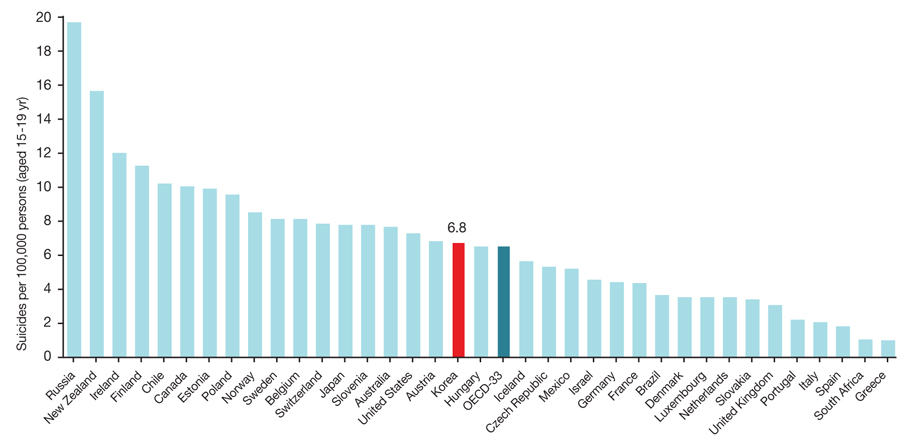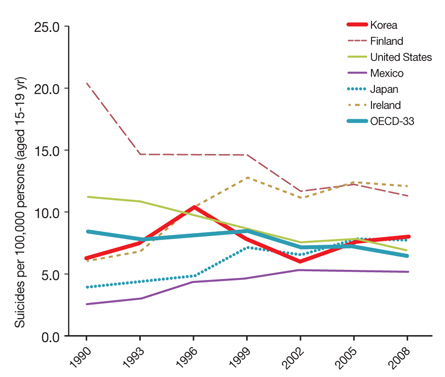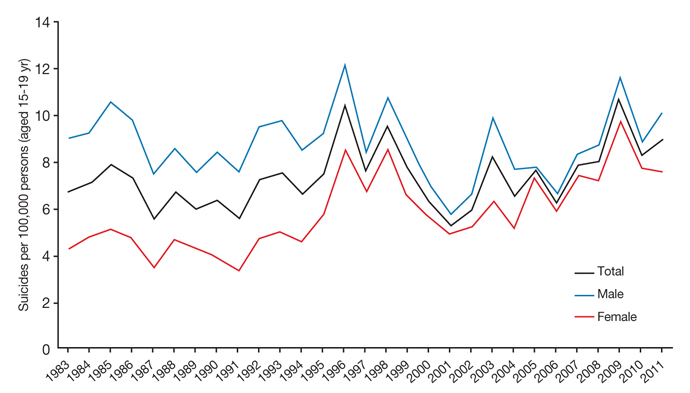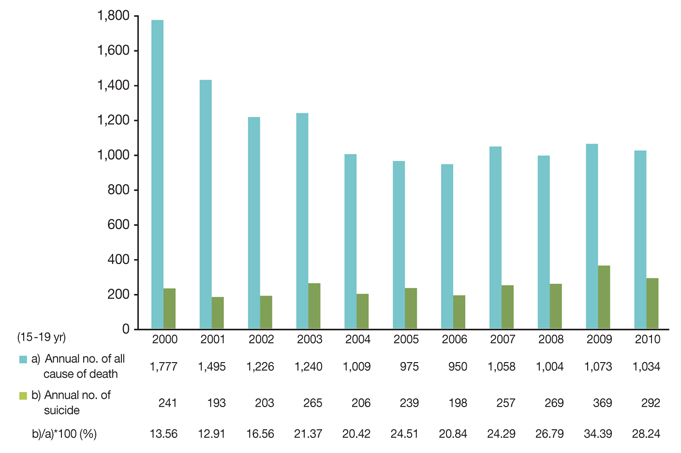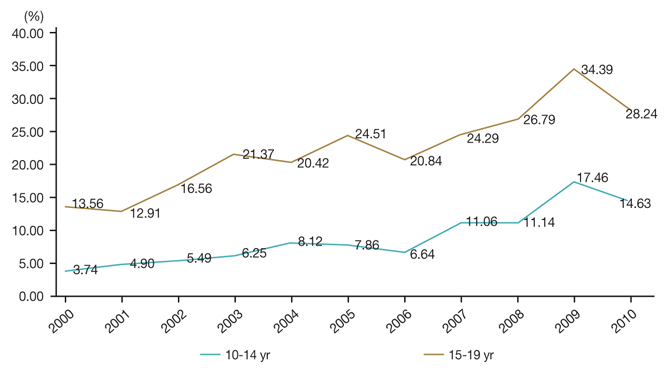Recent statistics and risk factors of suicide in children and adolescents
- Affiliations
-
- 1Depression Center, Department of Psychiatry, Samsung Medical Center, Sungkyunkwan University School of Medicine, Seoul, Korea.
- 2Depression Clinical and Research Program, Department of Psychiatry, Massachusetts General Hospital, Harvard Medical School, Boston, MA, USA.
- 3Korea Youth Counselling and Welfare Institute, Seoul, Korea.
- 4Department of Psychiatry, Seoul Paik Hospital, Inje University School of Medicine, Seoul, Korea. jongmin.woo@gmail.com
- 5Stress Research Institute, Inje University, Seoul, Korea.
- 6National Evidence-based Healthcare Collaborating Agency, Seoul, Korea.
- KMID: 1785377
- DOI: http://doi.org/10.5124/jkma.2013.56.2.93
Abstract
- Youth suicide is like the tip of an iceberg; while many adolescents have died from suicide, many more adolescents have been harmed by suicide attempts and self-injury. Suicide influences not only the victims, but also their family members, friends, teachers, and neighbors. Witnesses can suffer from posttraumatic stress disorder. Suicide is the second leading cause of death among adolescents worldwide and the first cause of death among Korean adolescents. The number of suicides in Korea, especially among high school students and female students, is rapidly increasing when compared with Western countries. Suicide accounted for 28.2% of deaths among Korean adolescents in 2010. There were 4.44% and 18.97% of adolescents who had attempted suicide and had experienced suicidal ideation in their lifetime, which shows that many adolescents have a potential risk for suicide. Previous studies in Western countries have revealed that risk factors for adolescent suicide consist of three categories: sociodemographic factors (male and low socioeconomic and educational status), mental health factors (depression and drug abuse), and individual negative life events and family diversity (family history of suicidal behavior, parental death, and child abuse). In conclusion, suicide is common and rapidly increasing in Korean adolescents. However, the risk factors of suicide and suicide behaviors in Korean adolescents are yet to be determined. A well-designed nationwide survey is needed to investigate the prevalence and risk factors of suicide behaviors and mental disorders among Korean adolescents.
Keyword
MeSH Terms
Figure
Cited by 3 articles
-
Association between Early Spermarche and Suicide Attempts in Boys: the Korea Youth Risk Behavior Web-based Survey
Young-Ji Lee, In-Young Ahn, Bong-Jo Kim, Cheol-Soon Lee, Boseok Cha, So-Jin Lee, Jiyeong Seo, Jae-Won Choi, Youn Jung Lee, Eunji Lim, Dongyun Lee
J Korean Med Sci. 2021;36(11):e73. doi: 10.3346/jkms.2021.36.e73.The Characteristics of Students Who Had Attempted Self-Injury or Suicide in Chungcheongdo ‘Professional School Visits Outreach Project’
Je Jung Lee, Yun Hyoung Kang, Hyun Ju Hong, Young Hoon Kim, Jung-Woo Son
J Korean Neuropsychiatr Assoc. 2020;59(1):44-50. doi: 10.4306/jknpa.2020.59.1.44.The Factor Associated with Suicide Risk of High School Students Using the Adolescent Mental Health and Problem Behavior Screening Questionnaire-II
Hwa-Jin Oh, Keun-Mi Lee, Seung-Pil Jung
Korean J Health Promot. 2016;16(3):162-173. doi: 10.15384/kjhp.2016.16.3.162.
Reference
-
1. Jeon HJ. Depression and suicide. J Korean Med Assoc. 2011. 54:370–375.
Article2. Bae SB, Woo JM. Suicide prevention strategies from medical perspective. J Korean Med Assoc. 2011. 54:386–391.
Article3. World Health Organization. WHO suicide prevention. 2011. Geneva: World Health Organization.4. Hawton K, Saunders KE, O'Connor RC. Self-harm and suicide in adolescents. Lancet. 2012. 379:2373–2382.
Article5. Jeon HJ, Lee JY, Lee YM, Hong JP, Won SH, Cho SJ, Kim JY, Chang SM, Lee HW, Cho MJ. Unplanned versus planned suicide attempters, precipitants, methods, and an association with mental disorders in a Korea-based community sample. J Affect Disord. 2010. 127:274–280.
Article6. American Academy of Child and Adolescent Psychiatry. Practice parameter for the assessment and treatment of children and adolescents with schizophrenia. American Academy of Child and Adolescent Psychiatry. J Am Acad Child Adolesc Psychiatry. 2001. 40:7 Suppl. 4S–23S.7. World Health Organization. WHO mortality database. 2011. Geneva: World Health Organization.8. Organization for Economic Cooperation and Development. Teenage suicide (15-19 years old) [Internet]. 2011. cited 2013 Jan 16. Paris: Organization for Economic Cooperation and Development;Available from: http://www.oecd.org/social/familiesandchildren/48968307.pdf.9. Centers for Disease Control and Prevention. Suicide prevention: youth suicide. 2012. Atlanta: Centers for Disease Control and Prevention.10. Statistics Korea. Suicide rates: aged from 15 to 19 years in Korea. 2012. Daegeon: Statistics Korea.11. Ahn J, Hahn CS, Woo JM, Kim K. A study on Korean psychiatric disorder research: depression and suicide. 2012. Seoul: National Evidence-based Healthcare Collaborating Agency.12. Renaud J, Berlim MT, McGirr A, Tousignant M, Turecki G. Current psychiatric morbidity, aggression/impulsivity, and personality dimensions in child and adolescent suicide: a case-control study. J Affect Disord. 2008. 105:221–228.
Article13. Chronis-Tuscano A, Molina BS, Pelham WE, Applegate B, Dahlke A, Overmyer M, Lahey BB. Very early predictors of adolescent depression and suicide attempts in children with attention-deficit/hyperactivity disorder. Arch Gen Psychiatry. 2010. 67:1044–1051.
Article14. Aseltine RH Jr, Schilling EA, James A, Glanovsky JL, Jacobs D. Age variability in the association between heavy episodic drinking and adolescent suicide attempts: findings from a large-scale, school-based screening program. J Am Acad Child Adolesc Psychiatry. 2009. 48:262–270.
Article15. Russell ST, Joyner K. Adolescent sexual orientation and suicide risk: evidence from a national study. Am J Public Health. 2001. 91:1276–1281.
Article16. Glowinski AL, Bucholz KK, Nelson EC, Fu Q, Madden PA, Reich W, Heath AC. Suicide attempts in an adolescent female twin sample. J Am Acad Child Adolesc Psychiatry. 2001. 40:1300–1307.
Article17. Compton MT, Thompson NJ, Kaslow NJ. Social environment factors associated with suicide attempt among low-income African Americans: the protective role of family relationships and social support. Soc Psychiatry Psychiatr Epidemiol. 2005. 40:175–185.
Article18. Walsh E, Eggert LL. Suicide risk and protective factors among youth experiencing school difficulties. Int J Ment Health Nurs. 2007. 16:349–359.
Article19. Swahn MH, Ali B, Bossarte RM, Van Dulmen M, Crosby A, Jones AC, Schinka KC. Self-harm and suicide attempts among high-risk, urban youth in the U.S.: shared and unique risk and protective factors. Int J Environ Res Public Health. 2012. 9:178–191.
Article20. Roberts RE, Roberts CR, Xing Y. One-year incidence of suicide attempts and associated risk and protective factors among adolescents. Arch Suicide Res. 2010. 14:66–78.
Article21. Kim HS, Chae YS, Bae YJ. The protective factors of suicide probability in religious male high school students. J Korean Acad Nurs. 2012. 42:1–8.
Article22. Lee JY, Hur JH. Family risk factors for child suicidal ideation. Korean J Youth Couns. 2003. 11:85–95.23. Kim IK, Cho NJ. The validation of structural models on adolescents’ suicidal ideation. Korean J Couns. 2006. 7:1189–1202.24. Moon KS. The effect of academic stress on suicidal impulse in adolescence: mediating roles of parent and peer attachment. Korean J Child Stud. 2006. 27:143–157.25. Hong YS. The effect of life stress on adolescent suicidal behaviors and the buffering effect of problem-solving ability. J Korean Soc Child Welf. 2005. 20:7–33.
- Full Text Links
- Actions
-
Cited
- CITED
-
- Close
- Share
- Similar articles
-
- Suicide Attempts and Risk Factors Among Children and Adolescents
- The Risk Factors of Suicidal Ideation according to Age Groups among the Adolescents in Korea
- The Influencing Factors on Suicide Attempt among Adolescents in South Korea
- Suicidal Behaviors of Culturally Diverse Adolescents with Sexual Experience: Using Date from the 10~12th Korean Youth Risk Behavior Web-based Survey
- A Comparative Study about Risk Factors Influencing Suicide Ideation between Korean and Multicultural Adolescents


